In the order of time-space we should now be approaching
the first cooking place, the first
3-stone place, viz. day 151 (May 31):
.jpg)
|
THE KOBA TEXT |
|
At the time of rongorongo the stars had drifted
ahead with ca 70 right ascension days: |
|
Itzam-Yeh defeated |
28 May (148), 3149 BC |
78 |
|
 |
|
1st 3-stone place |
21 May (141), 3114 BC |
71 |
|
Creation of our present world |
13 August (225), 3114 BC |
155 |
|
Och ta chan (Hun-Nal-Ye 'entered or became the sky') |
5 February (36), 3112 BC |
-
24 |
|
When counting time BC we have to be careful for the
year numbers are negative: |
|
From 13 August to the end of the year 3114 BC |
366 - 225 = 141 |
|
+
the year 3113 BC |
141 + 365 = 507 |
|
+
from 1 January to 5 February in the year 3112 BC |
507 + 36 = 543 = 3 * 181 |
|
543 - 366 = 6 * 29½ = 177 |
|
- 24 + 366 = 342 = 2 * 171 = 11 * 31
+ 1 |
|
5 he nahoo. |
1
ngeti uri. |
2
ngeti tea. |
|
... After Maeha and Teke had reached the
middle [ki vaenga] of the
yam plantation, Oti and Parahenga [Bara henga] went into
the house [ki roto ki te hare], picked up [he too mai]
the figure, put her on a stretcher (rango) and carried
her on board the canoe. (There) they left her ... [E:61]
→
They moved Te Takapau from *27 to *29, from
84 to 86.
Oti. To come to an
end; to suffice, to be enough: ku-oti-á, it is finished;
ina kai oti mo kai, there is not enough to eat; he-oti
á, there isn't anymore left, it's the last one; it's enough
with that. Vanaga. Ta.: 1. Oti, presage of death. Sa.:
oti, to die. 2. To cut. Mq.: koti, oti, id.
Sa.: 'oti, id. Ma.: koti, id. Churchill.
Hega. Hegahega, reddish,
ruddy. Hehega, to dawn; ki hehega mai te
raá, when the sun rises. Vanaga. Hehegaraa,
sunrise. PS Sa.: sesega, to be dazzled as by
the sun. Fu.: sega, the beginning of
daybreak. Niuē:
hegahega, the
red light or rays at sunset. Viti: sesē,
to dawn. Churchill. |
|
JULIAN EQUINOX (84) |
MARCH 26 |
27 (*6) |
 |
 |
 |
|
 |
 |
 |
 |
|
mauga |
kai |
May 30
(150) |
ragi |
|
|
Ga1-4 |
Ga1-5 |
Ga1-6 |
|
Rohini-4 (The Red One) /
Pidnu-sha-Shame-4 (Furrow of Heaven)
/
ANA-MURI-2 (Rear pillar - at the foot of which was
the place for tattooing)
ALDEBARAN
= α Tauri
(68.2),
THEEMIN = υ² Eridani
(68.5) |
no star listed (69) |
no star listed (70)
(3112 BC + AD 1842) *
365.25 / 26000 = 70 |
|
May 28 (148) |
29 (88 + 61) |
30 (*70) |
|
°May 24 (144) |
25 |
26 (*66) |
|
'May 1 (121) |
2 |
3 (*43) |
|
"April 17 (107) |
18 |
19 (*29) |
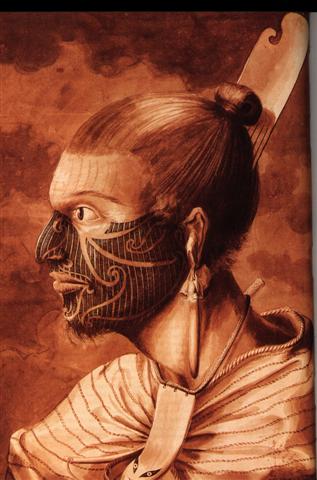 |
|
CLOSE TO THE FULL
MOON: |
|
SEPT 24 (84 + 183) |
25
(*188) |
26 |
|
HAN = ζ Ophiuchi
(251.0) |
ζ
Herculis,
η
Tr. Austr.
(252.1), η Herculis, β Apodis (252.5) |
ATRIA
=
α
Tr. Austr.
(253.9) |
|
Nov 27 |
28 |
29 (333) |
|
°Nov 23 |
24 (*248) |
25 (329) |
|
'Oct 31 |
'Nov 1 (*225) |
2 (306) |
|
"Oct 17 (*210) |
18 |
19 (292) |
 |
|
Variants of taro brought by Oti from
the plantation of Teke: |
|
1 |
69 |
ngeti uri. |
a Teke. a Oti. |
|
2 |
70 |
ngeti tea. |
|
3 |
71 |
he ngaatu. |
|
4 |
72 |
he tuitui koviro. |
|
5 |
73 |
he ketu anga mea. |
|
6 |
74 |
he ketu takarua. |
|
7 |
75 |
he teatea. |
|
8 |
76 |
he ngu haha tea. |
|
9 |
77 |
he mango. |
|
10 |
78 |
he hahara rapanui |
|
1 |
79 |
he ti. |
|
1 |
80 |
he kape. |
|
3 he ngaatu. (*71) |
4 he tuitui koviro. |
5 he ketu anga
mea. |
6 he ketu takarua. |
|
Gaatu, totora reed.
Vanaga. Gaatu 1.
Bulrush, reed. 2. (gatu). Churchill.Gatu.
Gaatu, totora reed. Gatu: 1. To
press, to tighten, to squeeze. 2. To pack tight.
3. To pull suddenly, to give a jerk. I ka
hakarogo atu, ku eke á te kahi, he gatu mai,
as soon as he felt the tuna be, he pulled in
[the line] with a sharp jerk. 4. To kick. 5.
E gatu te hagu, to wait for something
impatiently (gatu, breath). 6. Shortly,
very soon. He tu'u gatu, he is coming
shortly, he is just about to arrive. Vanaga.
Bulrush, reed. Gaatu (gatu) 1. To
feel of, to pinch, to throttle with the hands,
to touch, to press (gaatu); gatuga,
pressure; gatugatu, to trample down. T
Mgv.: natu, to press out linen, to
squeeze a person or a sore place. Mq.: natu,
to pinch. Ta.: natu, to pinch, to bruise.
2. To suppurate. 3. Gatu mai gatu atu,
sodomy. Gatua (gatu 1), tractable,
to press. Churchill. Scirpus riparius
var. paschalis. Barthel 2.
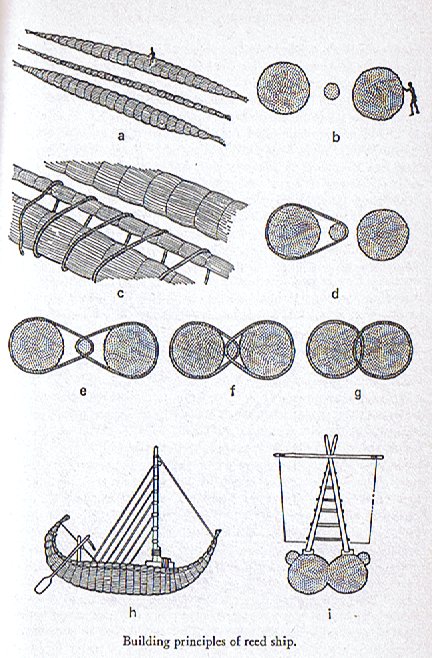
... All this,
which in so many ways parallels the normal
imagery of the Old World culture-hero myths,
telling of the one who is gone, dwells
underground in a happy, timeless land, as lord
of the realm of the happy dead, like Osiris,
but will rise again, we can read
without surprise. But what is
surprising indeed was the manner of
Quetzalcoatl's actual return. The priests
and astrologers did not know in what cycle he
was to reappear; however, the name of the year
within the cycle had been predicted, of old, by
Quetzalcoatl himself. Its sign was 'One
Reed' (Ce Acatl), which, in the Mexican
calendar, is a year that occurs only once in
every cycle of fifty-two. But the year when
Cortes arrived, with his company of fair-faced
companions and his standard, the cross, was
precisely the year 'One Reed'. The myth of the
dead and resurrected god had circumnavigated the
globe ...
Tui. 1. To sew mats, to make strings.
E-tahi tuitui reipá i Te Pei, ekó rava'a e-varu
kaukau; i-garo ai i Hiva, i te kaiga,
a necklace of mother-of-pearl is on te Pei,
few will find it (lit: eight groups of
people); it has remained in Hiva, in our
homeland. 2. The three stars of Orion's Belt.
Vanaga.
Aga. Work; to work, to make, to build, to
create: O te atua i-aga-ai i te ragi, i te
henua. God made heaven and earth. Vanaga.
Agahuru (hagahuru, hagauru).
Agai (hagai). Agatahi (aga-tahi)
one, (hagatahi); agatahi ahi atu,
day before yesterday; hagatahi ahi,
yesterday. Churchill.
Ketu. To bound, to climb over, to leap,
to jump, to raise (keetu). Mq. ketu,
to raise, to lift. Ketuketu, to spread
out, hihi ketuketu, to turn back
the eyelids. Churchill. Pau.: Ketuketu,
to dig. Ta.: etuetu, id. Mq.: ketu,
to dig up with the snout. Ma.: ketu, id.
Churchill. Mq.: ketuketu, to snuff a
candle. Sa.: eueu, id. Churchill.
Taka,
takataka. Circle; to form circles,
to gather, to get together (of people). Vanaga.
1. A dredge. P Mgv.:
akataka,
to fish all day or all night with the line, to
throw the fishing line here and there. This can
only apply to some sort of net used in fishing.
We find in Samoa
ta'ā a small fishing line, Tonga taka
the short line attached to fish hooks, Futuna
taka-taka a fishing party of women in the
reef pools (net), Maori takā the thread
by which the fishhook is fastened to the line,
Hawaii kaa in the same sense, Marquesas
takako a badly spun thread, Mangareva
takara a thread for fastening the bait on
the hook. 2. Ruddy. 3. Wheel, arch; takataka,
ball, spherical, round, circle, oval, to roll in
a circle, wheel, circular piece of wood, around;
miro takataka, bush; haga takataka,
to disjoin; hakatakataka, to round, to
concentrate. P Pau.: fakatakataka, to
whirl around. Mq.: taka, to gird. Ta.:
taa, circular piece which connects the frame
of a house. Churchill.Takai, a curl, to
tie; takaikai, to lace up; takaitakai,
to coil. P Pau.: takai, a ball, to tie.
Mgv.: takai, a circle, ring, hoop, to go
around a thing. Mq.: takai, to voyage
around. Ta.: taai, to make into a ball,
to attach. Churchill. |
|
MARCH 28 |
29 (88 = 39 +
49) |
30 |
31 (*10) |
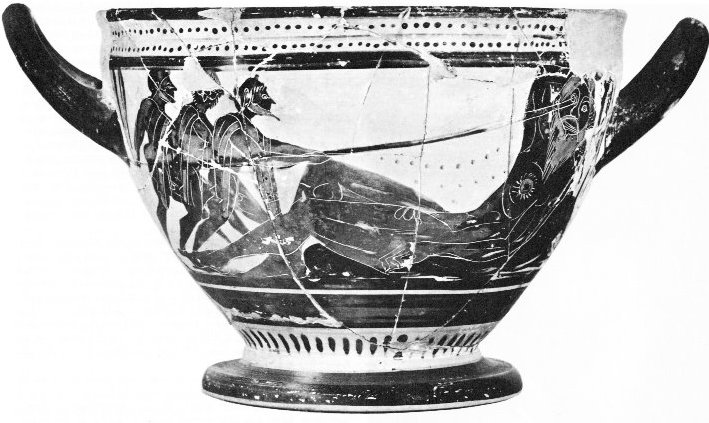
... 'Yes, for he was a monstrous thing and
fashioned marvelously, nor was he like to any
man that lives by bread, but like a wooded peak
of the towering hills, which stands out apart
and alone from others.' Odysseus, choosing
twelve men, the best of the company, left his
ships at shore and sallied to the vast cave. It
was found stocked abundantly with cheeses,
flocks of lambs and kids penned apart, milk
pails, bowls of whey; and when the company had
entered and was sitting to wait, expecting
hospitality, the owner came in, shepherding his
flocks. He bore a grievous weight of dry wood,
which he cast down with a din inside the cave,
so that in fear all fled to hide. Lifting a huge
doorstone, such as two and
twenty good [maitaki] four-wheeled
wains could not have raised from the ground, he
set this against the mouth of the cave, sat
down, milked his ewes and goats, and beneath
each placed her young, after which he kindled a
fire and spied his guests ...
... The earliest depiction
that has been linked to the constellation of
Orion is a prehistoric (Aurignacian) mammoth
ivory carving found in a cave in the Ach valley
in Germany in 1979. Archaeologists have
estimated it to have been fashioned
approximately 32,000 to 38,000 years ago ... The
artist cut, smoothed and carved one side (A)
and finely notched the other side (B)
and the edges. Side A contains the
half-relief of an anthropoidal figure, either
human or a human-feline hybrid, known as the
'adorant' because its arms are raised as if in
an act of worship.
On side B together with the four edges
is a series of notches that are clearly set in
an intentional pattern. The edges contain a
total of 39 notches in groups of 6, 13, 7 and
13. A further 49 notches on side B are
arranged in four vertical lines of 13, 10, 12
and 13 respectively plus a further notch that
could be in either of the middle two lines ...
The grouping of the notches on the plate
suggests a time-related sequence.
The total number of notches (88) not only
coincides with the number of days in 3 lunations
(88.5) but also approximately with the number of
days when the star Betelgeuse (α Ori)
disappeared from view each year
between its heliacal set (about 14 days before
the spring equinox around 33,000 BP) and its
heliacal rise (approximately 19 days before the
summer solstice). Conversely, the nine-month
period when Orion was visible in the sky
approximately matched the duration of human
pregnancy, and the timing of the heliacal rise
in early summer would have facilitated a ‘rule
of thumb’ whereby, by timing conception close to
the reappearance of the constellation, it could
be ensured that a birth would take place after
the severe winter half-year, but leaving enough
time for sufficient nutrition of the baby before
the beginning of the next winter. There is a
resemblance between the anthropoid on side A and
the constellation Orion. None of these factors
is convincing when taken in isolation, because
of the high probability that apparently
significant structural and numerical
coincidences might have arisen fortuitously.
However, taken together they suggest that the
anthropoid represented an asterism equivalent to
today’s constellation of Orion, and that the
ivory plate as a whole related to a system of
time reckoning linked to the moon and to human
pregnancy. If so, then ethnographic comparisons
would suggest that the Geißenklösterle
culture related their ‘anthropoid’ asterism to
perceived cycles of cosmic power and fertility
...
 |
 |
 |
 |
 |
|
Ga1-7 |
Ga1-8 |
Ga1-9 |
Ga1-10 |
|
TABIT
=
π³
Orionis
(71.7),
π²
Orionis (71.9)
*320 (South Pole star, Dramasa) - *71 (Tabit) =
*249 (Antares) |
π4
Orionis (72.1),
ο¹
Orionis (72.4),
π5
Orionis (72.8)
*31.0 = *72.4 - *41.4 |
π¹
Orionis (73.0),
ο²
Orionis (73.4),
HASSALEH
=
ι
Aurigae
(73.6),
π6
Orionis (73.9)
*32.0 = *73.4 - *41.4 |
ALMAAZ (The Male Goat)
=
ε
Aurigae
(74.7),
HAEDUS I
=
ζ
Aurigae
(74.8) |
 |
|
May 31 |
June 1 (152) |
2 (*73) |
3 |
|
°May 27 |
28 (148) |
29 |
30 |
|
'May 4 |
5 (125) |
6 (*46) |
7 |
|
"April 20 |
21 (111) |
22 (*32) |
23 |
|
CLOSE TO THE
FULL MOON: |
|
SEPT 27 (270 = 3 * 90) |
28 |
29 |
30 (*193) |
|
Tail-6 (Tiger)
WEI (Tail)
= ε Scorpii,
η Arae (254.3),
DENEBAKRAB
= μ Scorpii
(254.7) |
ι Ophiuchi (255.3),
GRAFIAS
(Claws)
= ζ Scorpii
(255.4)
*214.0 = *255.4 - *41.4 |
κ Ophiuchi (256.2), ζ Arae (256.5), ε Arae
(256.8),
CUJAM (Club)
= ε Herculi
(256.9) |
no star listed (257) |
|
Nov 30 |
Dec 1 |
2 (4 * 84 =
336) |
3 |
|
°Nov 26 |
27 |
28 |
29 (333) |
|
'Nov 3 |
4 |
5 |
6 (310) |
|
"Oct 20 |
21 (*214) |
22 (295) |
23 |
 |
Anciently there were 2 rulers, presumably one of them
representing Auriga and the other Orion:
... The meaning of basileus as 'king' in
Classical Greece is due to a shift in terminology during the
Greek Dark Ages. In Mycenaean times, a gwasileus appears
to be a lower-ranking official (in one instance a chief of a
professional guild), while in Homer, Anax is already an archaic
title, most suited to legendary heroes and gods rather than for
contemporary kings. The Greek title
has been compared to Sanskrit ... vanij,
a word for 'merchant', but in the Rigveda once used as a title
of Indra. The word could then be from PIE *wen-ag'-,
roughly 'bringer of spoils' (compare the etymology of lord,
'giver of bread'). Archaic inscription (...)i
wanakti, 'to the king', on [a}ceramic fragment, here
shown upside down; a warrior bearing a spear and mounted on a
horse is also depicted:

... The 'giver of bread' (Lord) should
indicate the king who enters at the beginning of summer (through
the Π door) and the 'bringer of
spoils' (Anax) the other king who enters at the beginning of
winter (through the underground Η
door).
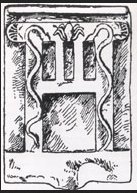
... One of the signs of the
Gemini twins was the dokana: ... On votive
reliefs they are depicted with a variety of symbols
representing the concept of twinhood, such as the dokana
(δόκανα - two upright piece of wood connected by two
cross-beams), a pair of amphorae, a pair of shields, or a
pair of snakes ...
... At top right is a pair of structures, formed somewhat like H
H and in the central position, standing on a podium, is a pair
of 'urns'. To the left is the pair of twins, Castor and Pollux
...
... This picture I once copied from The Cult of the
Heavenly Twins by J. Rendel Harris, a book I had
borrowed because I was intrigued by a reference in
Hamlet's Mill:
In the Gospel of Mark III.17, the 'twins'
James and John, the sons of Zebedee, are given by Jesus the
name of Boanerges, which the Evangelist explains as meaning
'Sons of Thunder'. This was long overlooked but eventually
became the title of a work by a distinguished scholar, too
soon forgotten, Rendel Harris. Here the Thunder Twins were
shown to exist in cultures as different as Greece,
Scandinavia and Peru. They call to mind the roles of Magni
and Modi, not actually called twins, but successors of Thor,
in Ragnarok. But to quote from Harris:
We have shown that it does not
necessarily follow that when the parenthood of the Thunder
is recognized, it necessarily extends to both of the twins.
The Dioscuri may be called unitedly, Sons of Zeus; but a
closer investigation shows conclusively that there was a
tendency in the early Greek cults to regard one twin as of
divine parentage, and the other of human. Thus Castor is
credited to Tyndareus, Pollux to Zeus ...
The extra child made the trouble, and was
credited to an outside source. Only later will the
difficulty of discrimination lead to the recognition of both
as Sky-boys or Thunder-boys. An instance from a remote
civilization will show that this is the right view to take.
For example, Arriaga, in his 'Extirpation
of Idolatry in Peru' tells us that 'when two children are
produced at one birth, which they call Chuchos or Curi, and
in el Cuzco Taqui Hua-hua, they hold it for an impious and
abominable occurrence, and they say, that one of them is
the child of the Lightning, and require a severe
penance, as if they had committed a great sin'.
And it is interesting to note that when
the Peruvians, of whom Arriaga speaks, became Christians,
they replaced the name of Son of Thunder, given to one of
the twins, by the name of Santiago, having learnt from their
Spanish (missionary) teachers that St. James (Santiago) and
St. John had been called Sons of Thunder by our Lord, a
phrase which these Peruvian Indians seem to have understood,
where the great commentators of the Christian Church had
missed the meaning ...
Another curious and somewhat similar
transfer of the language of the Marcan story in the
folk-lore of a people, distant both in time and place ...
will be found, even at the present day, amongst the Danes
... Besides the conventional flint axes and celts, which
commonly pass as thunder-missiles all over the world, the
Danes regard the fossil sea-urchin as a thunderstone, and
give it a peculiar name. Such stones are named in Salling,
sebedaei-stones, s'bedaei; in North Salling
they are called sepadeie-stones. In Norbaek, in the
district of Viborg, the peasantry called them Zebedee
stones! At Jebjerg, in the parish of Cerum, district of
Randers, they called them sebedei-stones ...
The name that is given to these
thunderstones is, therefore, very well established, and it
seems certain that it is derived from the reference to the
Sons of Zebedee in the Gospel as sons of Thunder.
The Danish peasant, like the
Peruvian savage, recognised at once what was meant by
Boanerges, and called his thunderstone after its patron
saint. This might have given pause to later
hyperscholars like Bultmann, before they proceeded to
'de-mythologize' the Bible. One never knows what one
treads underfoot ...

But the pair of kingdoms - like those of Upper and
Lower Egypt - were eventually united by the Bull.

|
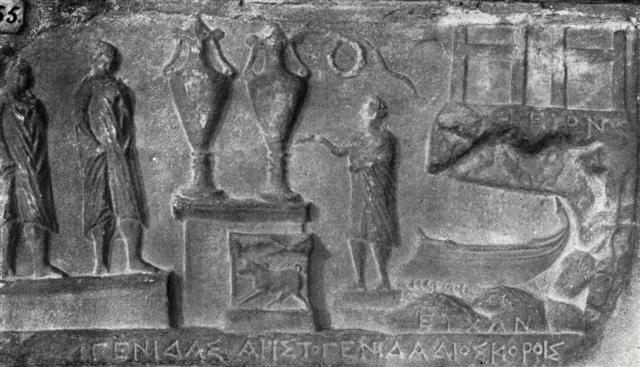
.jpg)

















